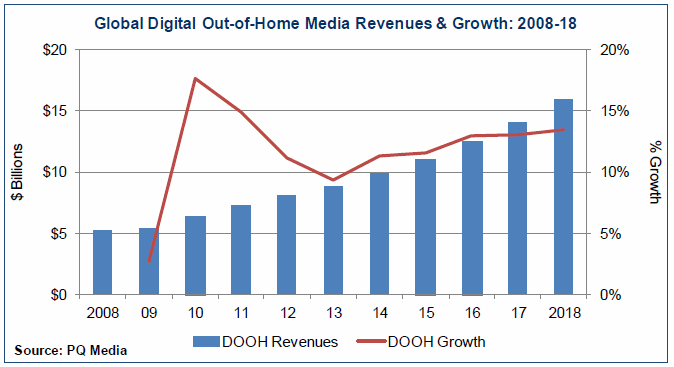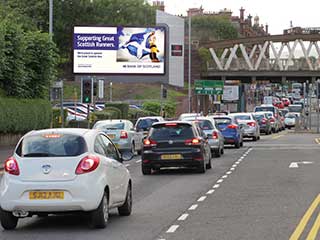Brave new reality of digital advertising
 LED screens of La Halle flagship store in Paris
LED screens of La Halle flagship store in ParisIn the ever-fragmenting world of media and advertising, it's the pairing of video and out-of-home (OOH) that's delivering results greater than the sum of its parts. This is changing the game for marketers eager to reach professional, frequent-shopping, elusive, light-TV-viewing audiences well beyond television and the Web.
The media environment is becoming ever-more fragmented into formats, applications, channels etc. All around us – at home, in the streets, in transit – we are being informed, lured, tempted. In these conditions the partnership between home TV and OOH video content may bring about the much desired result for advertisers.
Obviously, marketing experts are coming up with new ways to attract attention of well-to-do, professional, frequently shopping, elusive, uninterested in TV viewing audience. Trying to reach these people on home screens or via the Internet is not very effective.
It is necessary to tap into vast resources of outdoor advertising that is being transformed almost daily thanks to advances in digital applications. Today mediabuyers do not need to convince clients how important the digital outdoor segment is. Mediabuyers today are less confident in the effectiveness of television and more concerned about online video click fraud than ever before. This is one of the reasons why the Internet advertising spending is not growing as fast as it used to just a few years ago.
Among other reasons are such facts as the increase in the number of TV channels that naturally lead to audience fragmentation, lower ratings and reduced value of advertising time. Moreover, more and more people stop watching broadcasting TV since they prefer on-line viewing. In fact, from 2010 to 2014 in the USA alone the TV audience shrank by 5 million viewers. Those who think that TV advertising budgets should be moved to the Internet maybe mistaken as wee. The Internet-advertising is not trustworthy and is frequently associated with fraud.
The experts believe that up to one third of all advertising slots sold in the Internet never reach users’ eyes. The Interactive Advertising Bureau in the USA estimates that 30-35% of Internet advertising is fraudulent, the advertisers receive doctored reports on their ads visibility to consumers.

Global digital out-of-home media forecast 2014-2018
The diagram of DOOH Media Revenues and Growth created by the well-known and reputable analytics company PQ Media in 2014, demonstrates that in spite of the world economic depression the growth of revenues in the outdoor digital advertising did not slow down. In fact, the forecast for the next 3-4 years promises a stable growth up to the year 2018.
 On road digital billboard in city highway
On road digital billboard in city highwayFor this very reason money continues to flow into the outdoor advertising segment and in the manufacturing industry of digital outdoor carriers, primarily, LED screens and LCD monitors for indoor and transit applications. In 2013-14, the OOH advertising segment in the majority of developed countries was the second in growth rates, following only the mobile applications, but far ahead of traditional advertising segments of static advertising, TV, radio, newspapers and even the Internet.
It is a well-known fact that video content in the street is highly visible and does not annoy. This is why the conservative evaluations of consumer audience demonstrate drastic rise in popularity of OOH digital video. In 2007, an average person watched DOOH for approximately 7 hours a year. In 2014 this number doubled and reached 14 hours. Today consumers are susceptible to outdoor digital advertising, especially if it is coordinated with the information on their portable devices. People living in towns are spending more and more time out-of-home because of traffic jams and the general trend to spend time in entertainment and commercial centers.
Relatively recently there appeared a new form of digital advertising: Place-based advertising. If you travel by air, you watch in-flight entertainment – but in front of each new segment you have to watch advertising clips that you are unable to fast-forward or delete.
When taking a taxi, you watch a monitor in the headrest of the front seat showing funny, interesting, useful or useless clips – but always with advertising components – during your ride. Or if you wait for a lift in the lift-hall, you are probably watching the monitor in front of you for a minute or more.
Statistically, large brands are spending 2 to 5 percent of their advertising budgets on this type of place-based advertising. Such experienced advertisers as Coca-Cola, Ford, Verizon, P&G are trying to expand their broadcasting advertising segments by spending more on place-based advertising.
Many experts believe that place-based advertising is a premium segment. There are at least three reasons for that: Air-traveller or taxi-passenger are the people from the demographic group of the middle class, a class of people who buy a lot and who are mostly targeted by the majority of high brands. Secondly, the advertising from the closely placed monitor will be definitely watched by everyone nearby. And most importantly, place-based advertising is accountable.
Today, the guaranteed delivery of the content and proven measurement of the audience are the main stumbling blocks preventing even faster spread of the digital environment. For this reason many companies are competing in offering methods for guaranteed or “trusted” broadcasting.
We can remember the TV rating methods, video-counting of the passing vehicles, or eye-tracking, or counting the number of interactive advert-related text messages sent from the vicinity of an advertising screen. Modern technology allows to account for almost anything, but the measurement of the advertising audience remains a difficult task. However, even this task will be soon accomplished, and we will all be counted and accounted for.





